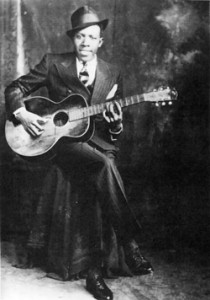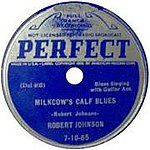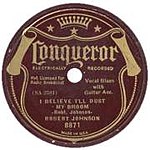Robert Johnson
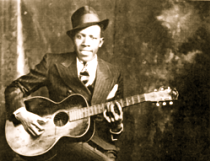
Robert Johnson – Come on in my Kitchen
The delta blues legend sings “Come on in my Kitchen:” “You better come on, in my kitchen, ’cause it’s going to be raining outdoors.”
Robert Johnson’s studio portrait, circa 1935—one of only three verified known published photographs
Robert Leroy Johnson (May 8, 1911 – August 16, 1938) was an American blues singer and musician. His landmark recordings from 1936–37 display a combination of singing, guitar skills, and songwriting talent that has influenced later generations of musicians. Johnson’s shadowy, poorly documented life and death at age 27 have given rise to much legend, including the Faustian myth that he sold his soul at a crossroads to achieve success. As an itinerant performer who played mostly on street corners, in juke joints, and at Saturday night dances, Johnson had little commercial success or public recognition in his lifetime.
Johnson’s records sold poorly during his lifetime. It was only after the reissue of his recordings in 1961 on the LP King of the Delta Blues Singers that his work reached a wider audience. Johnson is now recognized as a master of the blues, particularly of the Mississippi Delta blues style. He is credited by many rock musicians as an important influence; Eric Clapton has called Johnson “the most important blues singer that ever lived.” Johnson was inducted into the Rock and Roll Hall of Fame as an “Early Influence” in their first induction ceremony in 1986. In 2003, David Fricke ranked Johnson fifth in Rolling Stone‘s list of the 100 Greatest Guitarists of All Time.
Early life
Robert Johnson was born in Hazlehurst, Mississippi, possibly on May 8, 1911, to Julia Major Dodds (born October 1874) and Noah Johnson (born December 1884). Julia was married to Charles Dodds (born February 1865), a relatively prosperous landowner and furniture maker with whom she had 10 children. Charles Dodds had been forced by a mob to leave Hazlehurst following a dispute with white landowners. Julia left Hazlehurst with baby Robert but after some two years sent him to live in Memphis with her husband, who had changed his name to Charles Spencer.
Around 1919, Robert rejoined his mother in the area around Tunica and Robinsonville, Mississippi. Julia’s new husband was known as Dusty Willis; he was 24 years her junior. Robert was remembered by some residents as “Little Robert Dusty,” but he was registered at Tunica’s Indian Creek School as Robert Spencer. In the 1920 census he is listed as Robert Spencer, living in Lucas, Arkansas with Will and Julia Willis. Robert was at school in 1924 and 1927 and the quality of his signature on his marriage certificate suggests that he was relatively well educated for a boy of his background. One school friend, Willie Coffee, has been discovered and filmed, recalling that Robert was already noted for playing the harmonica and jaw harp. He also remembers that Robert was absent for long periods, which suggests that he may have been living and studying in Memphis.
After school, Robert adopted the surname of his natural father, signing himself as Robert Johnson on the certificate of his marriage to sixteen-year-old Virginia Travis in February 1929. She died in childbirth shortly after. Surviving relatives of Virginia told the blues researcher Robert “Mack” McCormick that this was a divine punishment for Robert’s decision to sing secular songs, known as ‘selling your soul to the Devil’. McCormick believes that Johnson himself accepted the phrase as a description of his resolve to abandon the settled life of a husband and farmer to become a full-time blues musician.
Around this time, the noted blues musician Son House moved to Robinsonville where his musical partner, Willie Brown, lived. Late in life, House remembered Johnson as a ‘little boy’ who was a competent harmonica player but an embarrassingly bad guitarist. Soon after, Johnson left Robinsonville for the area around Martinsville, close to his birthplace Hazlehurst, possibly searching for his natural father. Here he perfected the guitar style of Son House and learned other styles from Isaiah “Ike” Zinnerman. Ike Zinnerman was rumored to have learned supernaturally to play guitar by visiting graveyards at midnight. When Johnson next appeared in Robinsonville, he had seemed to have acquired a miraculous guitar technique. House was interviewed at a time when the legend of Johnson’s pact with the Devil was well known among blues researchers. He was asked whether he attributed Johnson’s technique to this pact, and his equivocal answers have been taken as confirmation.
While living in Martinsville, Johnson fathered a child with Vergie Mae Smith. He also married Caletta Craft in May 1931. In 1932, the couple moved to Clarksdale in the Delta. Here Caletta fell ill and Johnson abandoned her for a career as a ‘walking’ (itinerant) musician.
Itinerant musician
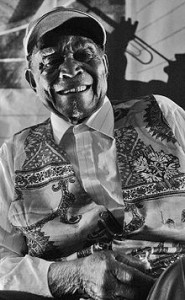 David “Honeyboy” Edwards was one of several blues guitarists whose testimony has been used to piece together Johnson’s history
David “Honeyboy” Edwards was one of several blues guitarists whose testimony has been used to piece together Johnson’s history
From 1932 until his death in 1938, Johnson moved frequently between large cities like Memphis, Tennessee and Helena, Arkansas and the smaller towns of the Mississippi Deltaand neighboring regions of Mississippi and Arkansas. On occasion, he traveled much farther. Fellow blues musician Johnny Shines accompanied him to Chicago, Texas, New York, Canada, Kentucky, and Indiana. Henry Townsend shared a musical engagement with him in St Louis. In many places he stayed with members of his large extended family, or with women friends. He did not marry again but formed some long term relationships with women to whom he would return periodically. One was Estella Coleman, the mother of the blues musician Robert Lockwood, Jr. In other places he stayed with a woman seduced at his first performance. In each location, Johnson’s hosts were largely ignorant of his life elsewhere. He used different names in different places, employing at least eight distinct surnames.
Biographers have looked for consistency from musicians who knew Johnson in different contexts: Shines, who traveled extensively with him; Lockwood who knew him as his mother’s partner; David “Honeyboy” Edwards whose cousin Willie Mae Powell had a relationship with Johnson. From a mass of partial, conflicting, and inconsistent eye-witness accounts, biographers have attempted to summarize Johnson’s character. “He was well mannered, he was soft spoken, he was indecipherable.” “As for his character, everyone seems to agree that, while he was pleasant and outgoing in public, in private he was reserved and liked to go his own way.” “Musicians who knew Johnson testified that he was a nice guy and fairly average—except, of course, for his musical talent, his weakness for whiskey and women, and his commitment to the road.”
When Johnson arrived in a new town, he would play for tips on street corners or in front of the local barbershop or a restaurant. Musical associates have said that in live performances Johnson often did not focus on his dark and complex original compositions, but instead pleased audiences by performing more well-known pop standards of the day – and not necessarily blues. With an ability to pick up tunes at first hearing, Johnson had no trouble giving his audiences what they wanted, and certain of his contemporaries later remarked on Johnson’s interest in jazz and country music. Johnson also had an uncanny ability to establish a rapport with his audience; in every town in which he stopped, Johnson would establish ties to the local community that would serve him well when he passed through again a month or a year later.
Fellow musician Shines was 17 when he met Johnson in 1933. He estimated Johnson was maybe a year older than himself. In Samuel Charters’ Robert Johnson, the author quotes Shines as saying:
“Robert was a very friendly person, even though he was sulky at times, you know. And I hung around Robert for quite a while. One evening he disappeared. He was kind of a peculiar fellow. Robert’d be standing up playing some place, playing like nobody’s business. At about that time it was a hustle with him as well as a pleasure. And money’d be coming from all directions. But Robert’d just pick up and walk off and leave you standing there playing. And you wouldn’t see Robert no more maybe in two or three weeks … So Robert and I, we began journeying off. I was just, matter of fact, tagging along.”
During this time Johnson established what would be a relatively long-term relationship with Estella Coleman, a woman about fifteen years his senior and the mother of musician Robert Lockwood, Jr. Johnson reportedly cultivated a woman to look after him in each town he played in. Johnson supposedly asked homely young women living in the country with their families whether he could go home with them, and in most cases the answer was ‘yes’…until a boyfriend arrived or Johnson was ready to move on.
In 1941, Alan Lomax learned from Muddy Waters that Johnson had performed in the Clarksdale, Mississippi area. By 1959, historian Samuel Charters could only add that Will Shade of the Memphis Jug Band remembered Johnson had once briefly played with him in West Memphis, Arkansas. In the last year of his life, Johnson is believed to have traveled to St. Louis and possiblyIllinois, and then to some states in the East.
In 1938, Columbia Records producer John H. Hammond, who owned some of Johnson’s records, had record producer Don Law seek out Johnson to book him for the first “From Spirituals to Swing” concert at Carnegie Hall in New York. On learning of Johnson’s death, Hammond replaced him with Big Bill Broonzy, but still played two of Johnson’s records from the stage.
Recording sessions
In Jackson, Mississippi, around 1936, Johnson sought out H. C. Speir, who ran a general store and doubled as a talent scout. Speir put Johnson in touch with Ernie Oertle, who offered to record the young musician in San Antonio, Texas. The recording session was held on November 23, 1936 in room 414 of the Gunter Hotel in San Antonio, which Brunswick Records had set up to be a temporary recording studio. In the ensuing three-day session, Johnson played sixteen selections, and recorded alternate takes for most of these. Johnson reportedly performed facing the wall, which has been cited as evidence he was a shy man and reserved performer. This conclusion was played up in the inaccurate liner notes of the 1961 album King of the Delta Blues Singers. Ry Cooder speculates that Johnson played facing a corner to enhance the sound of the guitar, a technique he calls “corner loading.”
Among the songs Johnson recorded in San Antonio were “Come On In My Kitchen,” “Kind Hearted Woman Blues,” “I Believe I’ll Dust My Broom” and “Cross Road Blues.” The first songs to appear were “Terraplane Blues” and “Last Fair Deal Gone Down,” probably the only recordings of his that he would live to hear. “Terraplane Blues” became a moderate regional hit, selling 5,000 copies.
His first recorded song, “Kind Hearted Woman Blues”, was part of a cycle of spin-offs and response songs that began with Leroy Carr‘s “Mean Mistreater Mama” (1934). According to Wald, it was “the most musically complex in the cycle” and stood apart from most rural blues as a through-composed lyric, rather than an arbitrary collection of more-or-less unrelated verses. In contrast to most Delta players, Johnson had absorbed the idea of fitting a composed song into the three minutes of a 78 rpm side. Most of Johnson’s “somber and introspective” songs and performances come from his second recording session.
In 1937, Johnson traveled to Dallas, Texas, for another recording session in a makeshift studio at the Vitagraph (Warner Brothers) Building, 508 Park Avenue, where Brunswick Record Corporation was located on the third floor. Eleven records from this session would be released within the following year. Johnson did two takes of most of these songs and recordings of those takes survived. Because of this, there is more opportunity to compare different performances of a single song by Johnson than for any other blues performer of his time and place.
By the time he died, at least six of his records had been released in the South as race records.
Playback issues in extant recordings
The accuracy of the pitch and speed of the extant recordings has been questioned. In The Guardian‘s music blog from May 2010, Jon Wilde states that “the common consensus among musicologists is that we’ve been listening to [Robert] Johnson at least 20% too fast;” i.e., that “the recordings were accidentally speeded up when first committed to 78 [rpm records], or else were deliberately speeded up to make them sound more exciting.” He does not give a source for this statement. Sony/Legacy music executive Beryl Cohen Porter, who won a Grammy for the label’s 1991 reissue of Johnson’s works, “acknowledges there’s a possibility Johnson’s 1936–37 recordings were sped up, since the OKeh/Vocalion family of labels, which originally issued the material, was ‘notorious’ for altering the speed of its releases. ‘Sometimes it was 78 rpms, sometimes it was 81 rpms,’ he says. It’s impossible to check the original sources, since the metal stampers used to duplicate the original 78 discs disappeared years ago.”
Death
Johnson died on August 16, 1938, at the age of 27, near Greenwood, Mississippi. Although the cause of death is still unknown, there have been a number of theories offered, based on several differing accounts about the events preceding his death.
Johnson had been playing for a few weeks at a country dance in a town about 15 miles (24 km) from Greenwood. According to one theory, Johnson was murdered by the jealous husband of a woman with whom he had flirted. In an account by fellow blues legend Sonny Boy Williamson, Johnson had been flirting with a married woman at a dance, where she gave him a bottle of whiskey poisoned by her husband. Williamson advised him to never drink from an opened bottle, and Johnson replied, “Don’t ever knock a bottle out of my hand.” Soon after, he was offered another (poisoned) bottle and accepted it. Johnson is reported to have begun feeling ill the evening after and had to be helped back to his room in the early morning hours. Over the next three days his condition steadily worsened and witnesses reported that he died in a convulsive state of severe pain. Musicologist Robert “Mack” McCormick claims to have tracked down the man who murdered Johnson, and to have obtained a confession from him in a personal interview, but has declined to reveal the man’s name.
While strychnine has been suggested as the poison that killed Johnson, at least one scholar has disputed the notion. Tom Graves, in his book Crossroads: The Life and Afterlife of Blues Legend Robert Johnson, relies on expert testimony from toxicologists to argue that strychnine has such a distinctive odor and taste that it cannot be disguised, even in strong liquor. Graves also claims that a significant amount of strychnine would have to be consumed in one sitting to be fatal, and that death from the poison would occur within hours, not days. Contemporary David “Honeyboy” Edwards similarly noted that the poison couldn’t have been strychnine, since Johnson would have died much more rapidly, instead of suffering for three days.
Gravesite
The exact location of his grave is officially unknown; three different markers have been erected at possible church cemetery burial sites outside of Greenwood.
- Research in the 1980s and 1990s strongly suggests Johnson was buried in the graveyard of the Mount Zion Missionary Baptist Church near Morgan City, not far from Greenwood, in an unmarked grave. A one-ton cenotaph in the shape of an obelisk, listing all of Johnson’s song titles, with a central inscription by Peter Guralnick, was placed at this location in 1990, paid for by Columbia Records and numerous smaller contributions made through the Mt. Zion Memorial Fund.
- In 1990 a small marker with the epitaph “Resting in the Blues” was placed in the cemetery of Payne Chapel near Quito, by the cemetery’s owner. This alleged burial site, in an apparent attempt to strengthen a claim, happens to be located in the center of Richard Johnson’s family plot.
- More recent research by Stephen LaVere (including statements from Rosie Eskridge, the wife of the supposed gravedigger) indicates that the actual grave site is under a big pecan tree in the cemetery of the Little Zion Church, north of Greenwood along Money Road. Sony Music has placed a marker at this site.
An interviewee in the documentary The Search for Robert Johnson (1991) suggests that owing to poverty and lack of transportation Johnson is most likely to have been buried in a pauper’s grave (or “potter’s field“) very near where he died.

